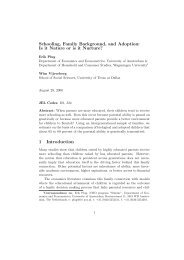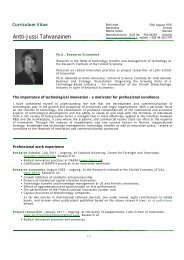Download PDF - Etla
Download PDF - Etla
Download PDF - Etla
You also want an ePaper? Increase the reach of your titles
YUMPU automatically turns print PDFs into web optimized ePapers that Google loves.
18<br />
At the same time, we must bear in mind that the organization may not always be the right<br />
level of analysis: there is at times drastic variance across the NPI projects within a firm, depending<br />
on the nature of the project. The same firm likely engages both in revolutionary design<br />
changes as well as minor adjustments of existing ones. Organization‐level studies<br />
should indeed be complemented by even more micro‐level analyses, where the unit of analysis<br />
is the new product development project.<br />
Table 2. Descriptive statistics on functional integration in the HPM data.<br />
Dimension<br />
IMPORTANCE OF<br />
FUNCTIONAL<br />
INTEGRATION<br />
AMOUNT OF<br />
CROSS‐<br />
FUNCTIONAL<br />
COOPERATION<br />
DIFFICULTY OF<br />
ACHIEVING<br />
FUNCTIONAL<br />
INTEGRATION<br />
EXTENT OF<br />
FUNCTIONAL<br />
INTEGRATION<br />
ACHIEVED<br />
Statement<br />
ʺMarketing and Finance<br />
know a great deal about<br />
manufacturingʺ<br />
ʺOther functions do not<br />
need to know about<br />
manufacturingʺ<br />
ʺFunctions communicate<br />
frequently with each otherʺ<br />
ʺOur functions work<br />
interactively with one<br />
anotherʺ<br />
ʺDepartments are in<br />
constant conflict with each<br />
otherʺ<br />
ʺProblems between<br />
functions are easily solvedʺ<br />
ʺThe functions of our firm<br />
are well integratedʺ<br />
ʺThe functions of our firm<br />
are well integratedʺ<br />
Dataset<br />
Distribution of responses<br />
Strongly<br />
Strongly<br />
1997 n=465 disagree Disagree Neutral Agree agree<br />
8.4% 31.4% 32.7% 24.5% 3.0%<br />
Strongly Slightly Slightly Strongly<br />
2004 n=526 disagree Disagree disagree Neutral agree Agree agree<br />
39.2% 41.8% 8.9% 4.4% 2.9% 1.9% 1.0%<br />
Strongly<br />
Strongly<br />
1997 n=2007 disagree Disagree Neutral Agree agree<br />
4.9% 16.7% 22.3% 43.0% 13.1%<br />
Strongly Slightly Slightly Strongly<br />
2004 n=524 disagree Disagree disagree Neutral agree Agree agree<br />
0.2% 1.5% 6.9% 7.3% 26.7% 46.0% 11.5%<br />
Strongly<br />
Strongly<br />
1997 n=1991 disagree Disagree Neutral Agree agree<br />
17.4% 32.6% 28.9% 16.4% 4.7%<br />
Strongly Slightly Slightly Strongly<br />
2004 n=522 disagree Disagree disagree Neutral agree Agree agree<br />
0.4% 2.5% 11.9% 13.0% 35.8% 31.0% 5.4%<br />
Strongly<br />
Strongly<br />
1997 n=463 disagree Disagree Neutral Agree agree<br />
0% 12% 32% 46% 9%<br />
Strongly Slightly Slightly Strongly<br />
2004 n=520 disagree Disagree disagree Neutral agree Agree agree<br />
0.2% 1.0% 8.1% 6.5% 32.3% 45.2% 6.7%<br />
6.2. AMOUNT OF CROSS‐FUNCTIONAL COOPERATION<br />
As Table 2 demonstrates, companies engage in cross‐functional cooperation in drastically<br />
varying degrees. For some organizations it is crucial, for others, it is not. Again, that a company<br />
does not engage in cross‐functional cooperation should not be viewed as negative: perhaps<br />
they do not need to spend time and effort coordinating their functions, and are thus<br />
more efficient. Maybe they do not have to work interactively with one another, which could<br />
be the case when reciprocal interdependence is absent. Again, these companies are more<br />
likely candidates to separate their R&D and manufacturing geographically as well and enjoy<br />
the benefits of locational advantages for both.<br />
6.3. DIFFICULTY OF ACHIEVING INTEGRATION<br />
Some companies struggle with functional integration, others do not. It would be very easy to<br />
attribute this to others having better management practices; smarter people, simply put.<br />
While this may be a plausible explanation, there is a compelling competing explanation: the<br />
difficulty is a manifestation of the requirements of the operating environment. Managing reciprocal<br />
interdependence is more difficult. Conflict can be political, but it can also be caused
















